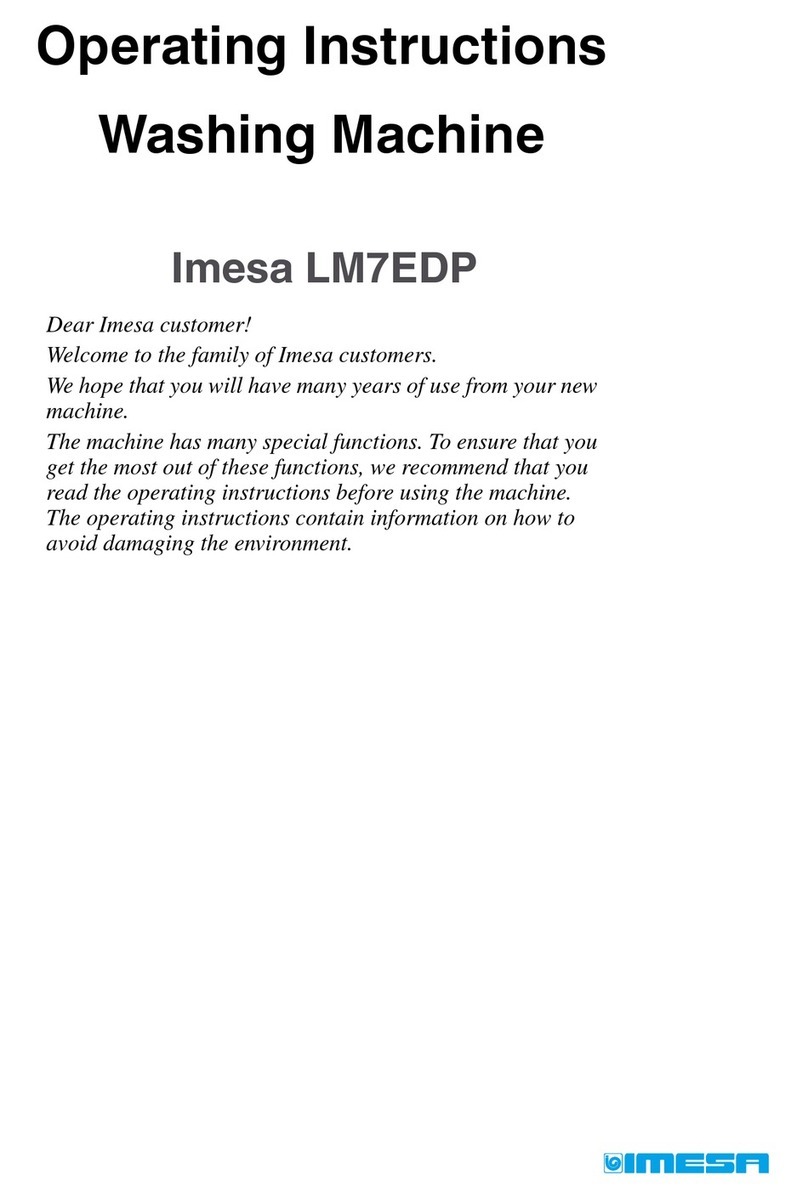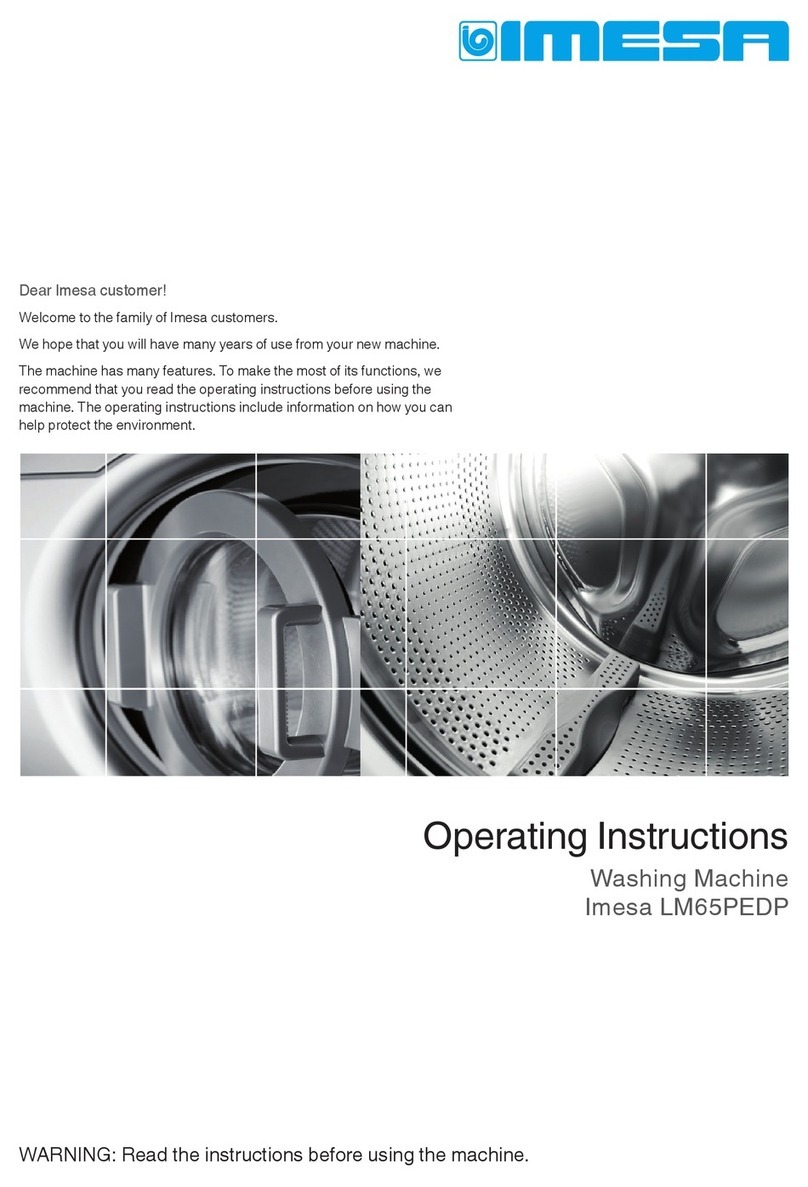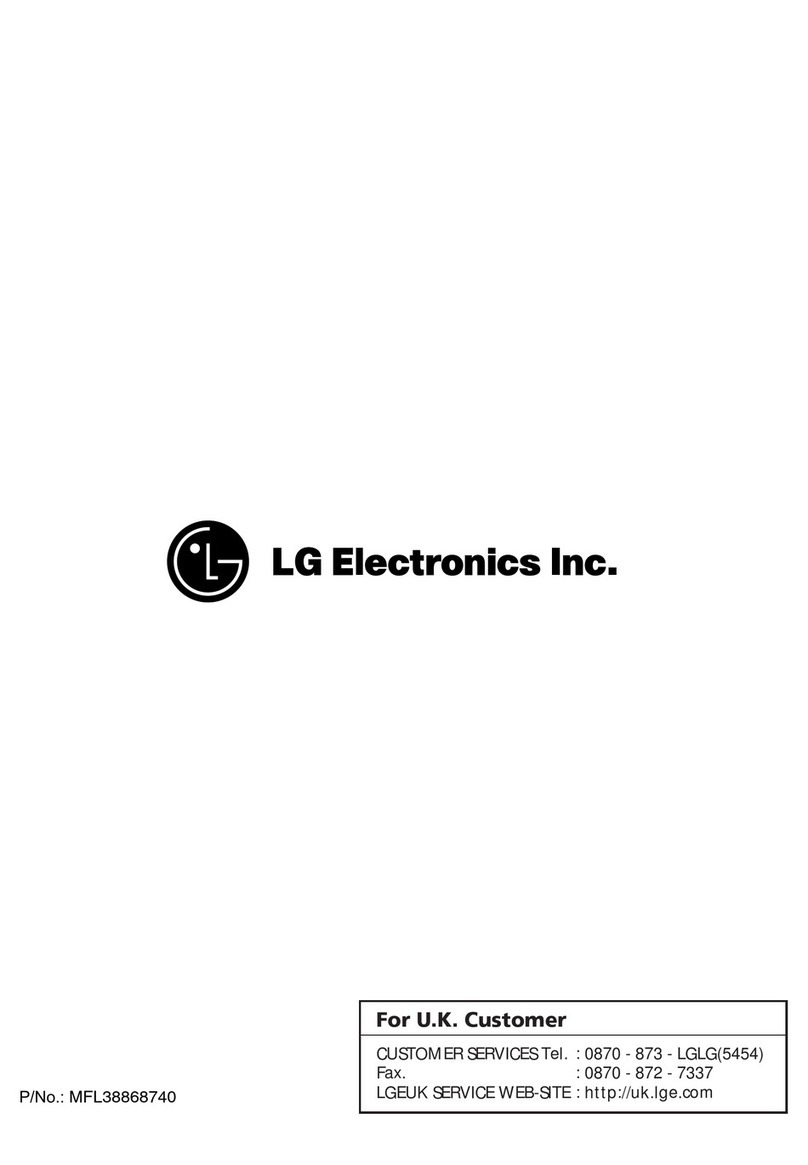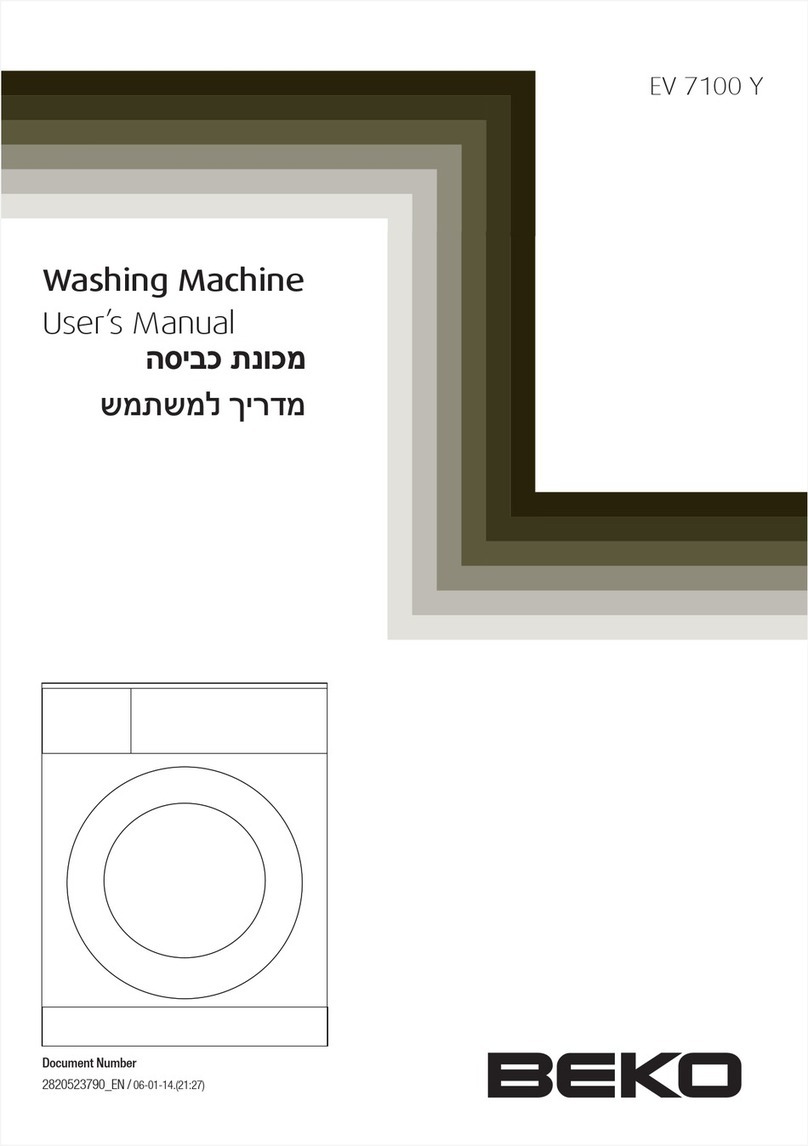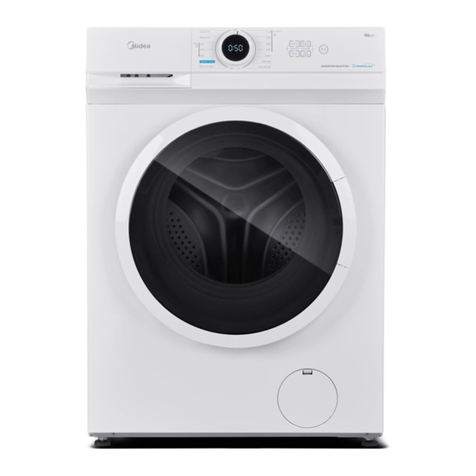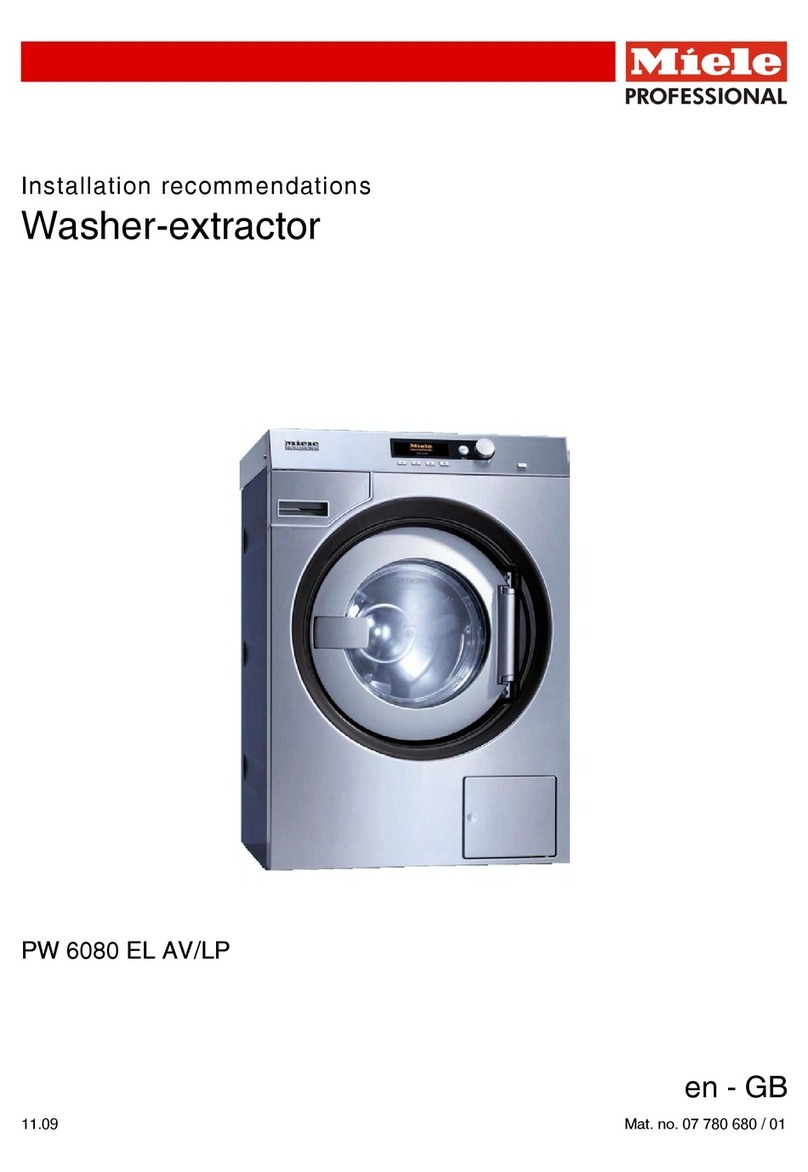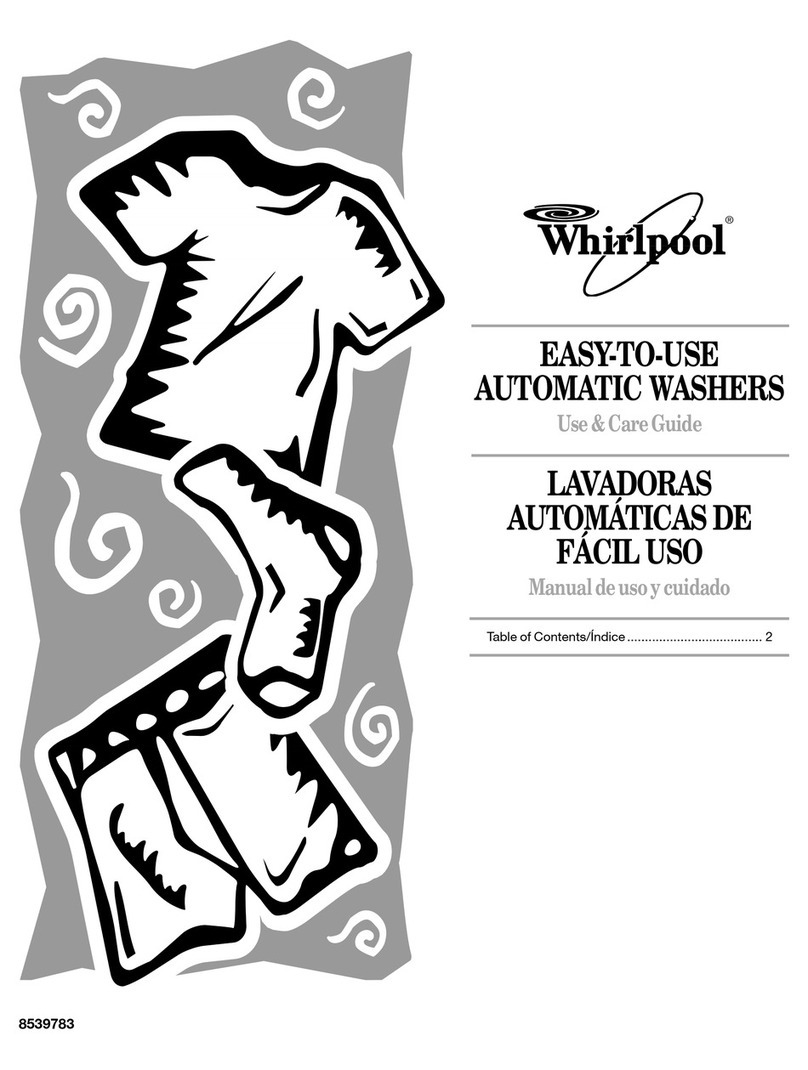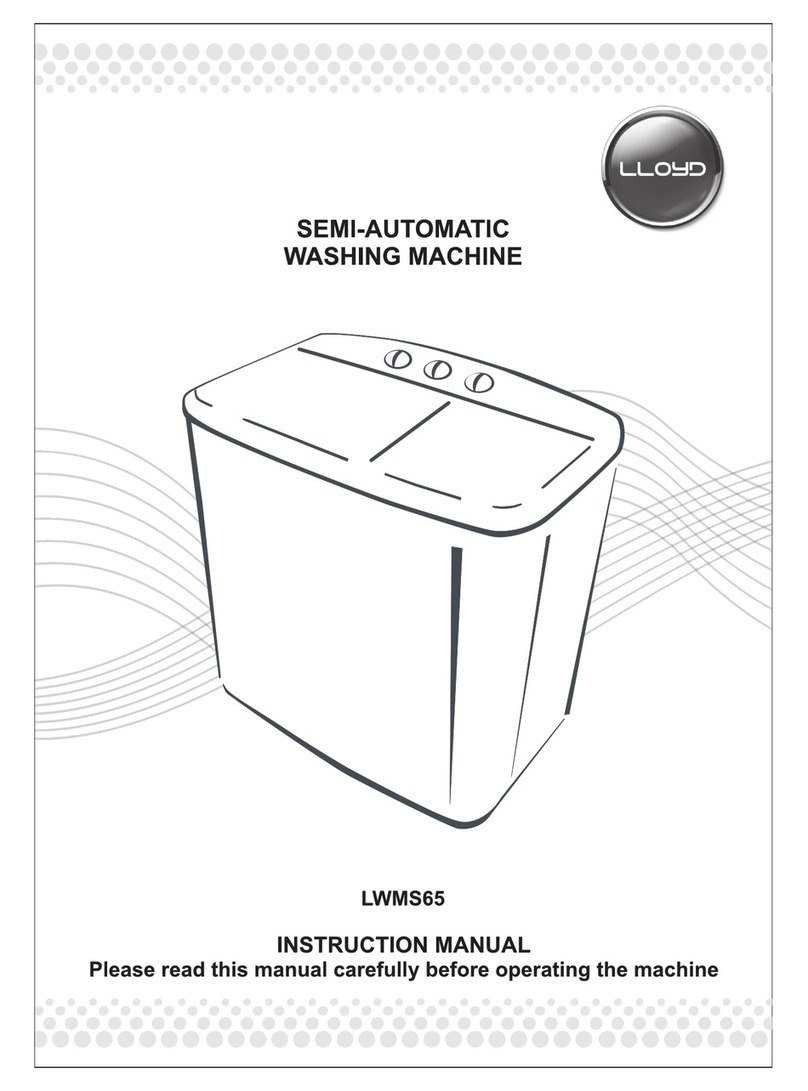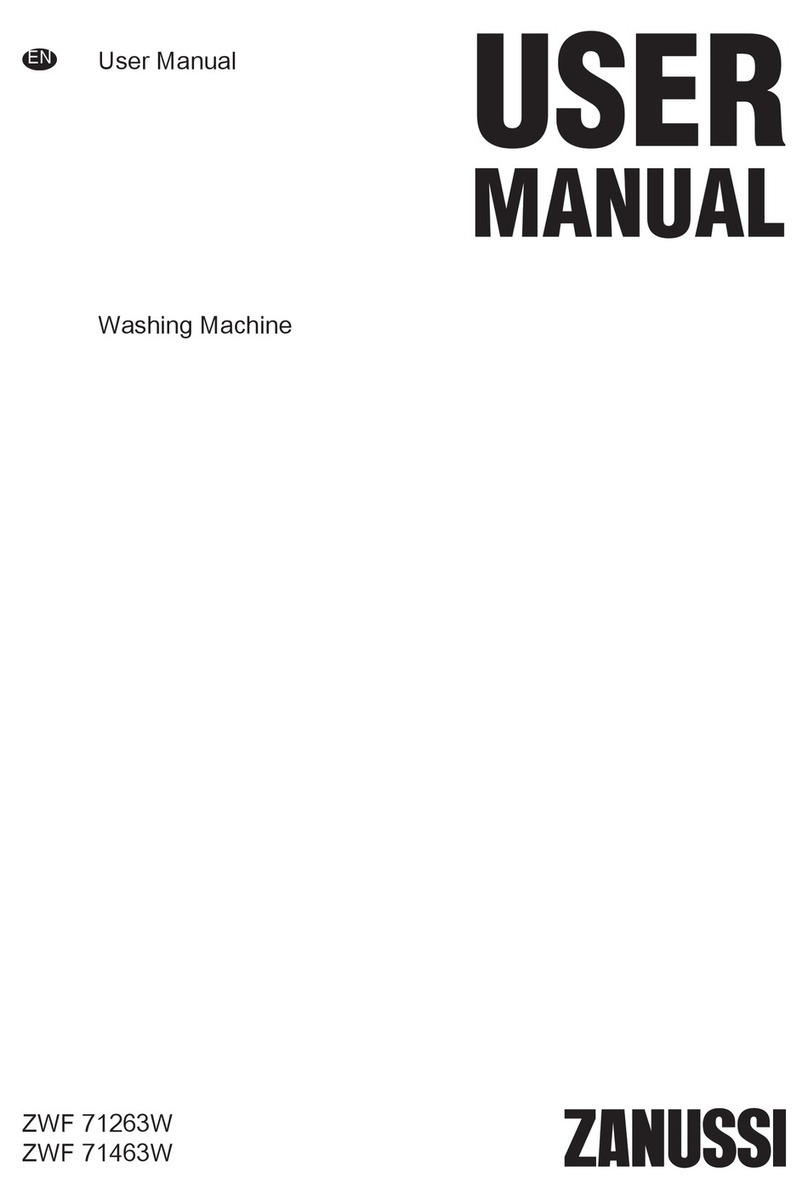Imesa LM80PEDP User manual

Operating Instructions
Washing Machine
Imesa LM80PEDP
Dear Imesa customer!
Welcome to the family of Imesa customers.
We hope that you will have many years of use from your new machine.
The machine has many features. To make the most of its functions, we
recommend that you read the operating instructions before using the
machine. The operating instructions include information on how you can
help protect the environment.
WARNING: Read the instructions before using the machine.

2
Translation of the original instructions
CONTENTS
SAFETY INSTRUCTIONS 3
Child safety 4
Installation 5
Overflow guard function 5
Transport/winter storage 5
Packing material 5
Recycling 5
ADVICE AND TIPS BEFORE WASHING 6
Sorting your laundry 6
Clothing 6
Laundry labels 6
Hot water connection 6
Coloured cotton 6
Unbleached linen 6
Wool 6
Rayon fibres and synthetic fibres 6
Detergents 6
USING YOUR WASHING MACHINE 7
Add detergent and fabric softener 7
Programme selection 8
Close the door and press the start button 8
During the programme 8
SETTINGS 9
Water intake 9
CARE AND CLEANING 10
Cleaning the trap and the drainage pump 10
Cleaning the detergent compartment 10
Cleaning the outside of the machine 10
Cleaning the inside of the machine to avoid
unpleasant smells 10
Rinse holes under the agitator 10
If you have hard water 11
TROUBLESHOOTING 12
The washer door will not open 12
Opening the door in an emergency 12
The machine will not start 12
After power failure 12
Wet washing still in the machine 12
Error messages 13
TECHNICAL INFORMATION 14
Information for test institute 14
Technical data 14
INSTALLATION 15
Positioning the washing machine 15
Adjusting the feet 15
Connection to water supply 15
Drainage connection 16
BEFORE CONTACTING THE SERVICE
DIVISION 17
Before contacting the service division 17
PROGRAMME CHART 18
QUICK GUIDE 20

3
SAFETY INSTRUCTIONS
GENERAL
• Keep the operating instructions in a
safe place.
• The machine should only be used for
washing items as described in these
instructions. It is not intended for dry
cleaning.
• Use only detergent intended for ma-
chine washing!
• Do not use detergents that contain
solvents as this could lead to release
of poisonous gases, damage to the
machine, and risk of fire and explo-
sion.
• Do not use colourants (dyes) or
bleaching substances (substances
for discolouration or removal of col-
ourants) as they contain sulphuric
compounds that could cause corro-
sion.
• Excessive use of products containing
chlorine compounds increases the
risk or premature failure of appliance
components.This depends on the
concentration of chlorine, exposure
time, and temperature.
• Bleaches that contain chlorine can
be replaced with oxygen-based
bleaches. Otherwise, a neutralization
cycle should be performed by run-
ning the Cotton program at the high-
est temperature. For best results, use
hydrogen peroxide or oxygen-based
detergents.
• Repairs and maintenance relating to
safety or performance must be car-
ried out by a qualified professional.
• Disconnect power to the machine
before repair and service.
• Damaged mains cables must only be
replaced by a qualified electrician.
• This machine can be used by children
aged 8 and upwards, and by peo-
ple with reduced physical capacity,
mental ability, memory loss or lacking
experience and knowledge. These
individuals must be supervised when
using the machine or have instruc-
tions on how to use the machine and
understand the risks that can occur.
• Cleaning and maintenance of the
machine must not be performed by
children without supervision.

4
CHILD SAFETY
• Children must be watched to ensure
they do not play with the machine.
• Always close the washer door and
start the programme immediately
after you have added detergent.
• Do not allow small children to use or
play with the washing machine.
• Store detergent and fabric softener
out of the reach of children.
Activate Child-safe start (button
lock)
You can activate the Child-safe start
option (button lock) to prevent children
from starting the washing machine (see
the Settings section).
Activate child safety catch (for
detergent compartment)
On the inside of the detergent
compartment is a child safety catch.
Activated child
safety catch
Inactivated child
safety catch
When the child safety catch is activated
you must press the release button to
pull out the detergent compartment.
SAFETY INSTRUCTIONS

5
SAFETY INSTRUCTIONS
INSTALLATION
• Conduct installation and connec-
tion in accordance with the separate
installation instructions.
• Installation of water and electricity,
if required, must be carried out by a
qualified professional.
• Remove any transport protection de-
vices before using the machine, see
the separate installation instructions.
OVERFLOW GUARD FUNCTION
If the water level in the machine rises
above normal, the overflow guard
function begins to pump water out
and shuts offthe water intake. If the
water level has not dropped within 60
seconds, the programme is terminated.
TRANSPORT/WINTER STORAGE
If the machine is to be transported or
stored in unheated premises where the
temperature can fall below freezing, do
as follows:
• Empty the filter and the drainage
pump. See the “Care and cleaning”
chapter.
• Shut offthe water to the washing ma-
chine, loosen the supply hose to the
intake valve and let the water run out
from the valve and hose.
• After emptying the pump, a small
amount of water may remain in the
machine.This does not affect quality
or damage the machine.
PACKING MATERIAL
Please sort waste materials in
accordance with local guidelines.
RECYCLING
This washing machine is manufactured
and labelled for recycling. In order to
prevent injuries, the machine must be
made unusable once the decision has
been taken to dispose of it. Contact
your local authority for information
about where and how your machine
should be correctly recycled.

6
ADVICE AND TIPS BEFORE WASHING
Here are some tips that may help you before washing.
SORTING YOUR LAUNDRY
Sort items according to:
• how soiled they are
• colour
• material
CLOTHING
1 Do up zips and close Velcro straps so that they don’t
harm fabrics.
2 New coloured items may contain excess dye and
should therefore be washed separately the first few
times.
3 Turn delicate items inside out. This reduces the risk of
burling and fading.
4 Empty pockets and wash them inside out if possible.
LAUNDRY LABELS
Look at the item’s laundry label. The table below shows
suitable wash programmes for different materials and
wash loads. Using modern washing machines and
detergents, for example compact detergents, you can
usually wash at lower temperatures. It is a good idea
to use trial and error to find out what produces the best
results.
HOT WATER CONNECTION
(depending on the model)
Hot water intake has a positive effect on grease stains
and certain pigment stains, such as oil, soot and coffee.
Note however that difficult protein stains with albumen
content (blood, milk, meat and fish) first need to be
soaked in cold water as they are difficult to dissolve at
temperatures above 40 °C. For the best washing results
we recommend the Super wash option and pre-soaking
the stained items in cold water before washing them in
the machine.
COLOURED COTTON
Coloured cotton garments labelled with washing
instruction 60°C must be washed at 60 °C initially to
remove any excess dye. Failure to observe this advice
could lead to the colour running. Use detergent without
bleach to preserve the colour of the fabric.
UNBLEACHED LINEN
Unbleached linen fabrics should be washed at 60 °C,
using detergent without bleach or optical brighteners.
Heavily soiled linen can be washed at higher
temperatures, but not too often as the heat may destroy
the sheen and strength of the linen.
WOOL
These fabrics are labelled for either machine wash or
for hand wash. The machine’s Wool/hand wash, 30 °C
programme is at least as gentle as washing by hand.
RAYON FIBRES AND SYNTHETIC
FIBRES
Materials made of rayon fibres, such as viscose, and
some synthetic fibres are very delicate and require much
space so as not to crease. Only half fill the drum when
washing and choose a spin speed of 800 rpm or lower.
NOTE!
Viscose and acetates are fragile when wet.
DETERGENTS
Eco-labelled detergents are less harmful to the
environment. Detergent overdosing does not give better
washing results; it merely causes a greater impact on
the environment. Try to use less detergent, and increase
only if you are not satisfied with the results.
NOTE!
Due to environmental concerns, we discourage the use
of strong chemicals.
When using agents for bleaching or stain removal,
there is a risk of rust (corrosion) and discolouration of
the machine.

7
USING YOUR WASHING MACHINE
ADD DETERGENT AND FABRIC
SOFTENER
14
5
6
23
1. Pre-wash
2. Main wash with liquid detergent.
Use the separator (A).
3. Main wash with powder detergent.
Do not use the separator.
4. Fabric softener
5. Release button
6. Child safety catch
A
B
C
The quantity of detergent needed depends, amongst
other things, on how hard the water is. See the detergent
pack for details. Phone your local water company to
check the water hardness in your area.
The detergent packaging will have recommendations
for how much detergent you should use. The machine
holds 8 kg of washing. If you only have a small amount
of laundry in the machine, you can reduce the amount of
detergent used.
Follow the manufacturers’ recommendations as
regards which type of detergent is suitable for which
temperature.
Powder detergent
Pour the powder into the compartment for the main
wash, and pre-wash as well if desired. Do not use the
separator in the main detergent compartment.
Liquid detergent
When using a liquid detergent, observe the detergent
manufacturer’s recommendations. We recommend
using a laundry ball with thick detergents. In the main
detergent compartment, use the section wall (A). Add
the detergent into the front compartment of the detergent
dispenser.
Wash ball or net
If you use a wash ball or net, place it directly in the drum
and select a programme without pre-wash.
NOTE!
Detergent overdosing does not give better washing
results; it merely causes a greater impact on the
environment.
Try using less detergent, and increase only if you are
not satisfied with the results.
Fabric softener
Pour the fabric softener into the compartment with the
symbol. Follow the recommendations on the fabric
softener packaging.
Start
Stop
Programme selector Time remainin
Program
Main power switch

8
USING YOUR WASHING MACHINE
Rinse
This programme performs one cold rinse cycle + spin.
Suitable for laundry that just needs to be dampened.
MOP wash, 90 °C
Programme suitable for different types of mop. The
programme has two rinses using much water.
MOP wash, 60 °C
Programme suitable for different types of mop. The
programme has two rinses using much water.
CLOSE THE DOOR AND PRESS THE
START BUTTON
NOTE!
A few seconds after you start a programme the washing
machine will begin to fill with water from both the hot
and the cold supplies. If for some reason no hot water
is available, the machine waits for one minute and then
fills with cold water only. The wash drum does not start
to rotate until it begins to fill with water.
The hot water inlet is only open for washing programs
with water temperature of 40 °C or higher.
DURING THE PROGRAMME
Time remaining
“Programme started” is shown on the display.
Stopping or changing a programme
You can stop a programme by pressing the Stop button
for three seconds. ”Stop” appears in the display. To
restart the machine, select a new programme, add any
extra detergent needed and press the Start button.
NOTE!
Do not open the detergent compartment while the
machine is running.
NOTE!
Do not fill above the compartment’s maximum fill level.
Otherwise fabric softener will run in too early, which
impairs the washing effect.
PROGRAMME SELECTION
The display shows the programme name, the water
temperature and the spin speed.
The washing machine has a number of preselected
programmes when delivered from the factory. The
preselected programmes can be replaced. Contact the
service division for information on which programmes
are available and how to alter the preselected
programmes.
White, 90 °C
Programme for normally to heavily soiled laundry. Follow
the washing instructions for each garment. 90 °C is a
good temperature for white and light-coloured cotton,
such as bed linen.
White/Colour, 60 °C
Programme for normally soiled laundry, whites and
colours. Follow the washing instructions for each
garment. 60 °C is a good temperature for garments worn
next to the skin.
White/Colour, 40 °C
Programme for normally soiled laundry, whites and
colours. Follow the washing instructions for each
garment.
Super quick wash, 60 °C
Fast programme for laundry that just needs freshening
up. Follow the washing instructions for each garment.
Garments worn next to the skin ought to be washed at
60°C.
Super quick wash, 40 °C
Fast programme for laundry that just needs freshening
up. Follow the washing instructions for each garment.
Synthetics, 40 °C
Programme for synthetics, delicate blended materials
and permanent press cotton. Suitable for shirts and
blouses. Follow the washing instructions for each
garment. Many synthetics will come clean at 40 °C.
Wool/hand wash, 30 °C
A gentle laundry programme for wool, silk and garments
that should be washed by hand. This programme has a
short spin.

9
SETTINGS
HOW TO CHOOSE THE SETTINGS
1 Turn offthe machine using the main power switch.
2 Press and hold the Stop button and then press the
main power switch. Then press the Stop button 5
times within 10 seconds.
3 Select the setting you want to change by turning the
programme selector.
4 Press the Stop once.
MAKING A SELECTION
Turn the programme selector until the desired selection
is shown in the display.
SAVING A SELECTION
1 Press Stop to save the selection and return to the
settings menu.
2 Press Start to go to the programme menu.
Options
Press Start to save the selection and return directly
to the programme menu, if you do not want to make
anymore settings.
LANGUAGE
Choose from: US English, AU English, Svenska, Dansk,
Norsk,Suomi, Français, Deutsch, Italiano, Espanol,
Русский, Nederlands, EU English.
CHILD-SAFE
You can activate the Child-safe start option to prevent
children from starting the machine. choose “Child-safe
On” or “Child-safe Off”.
Deactivate the Child-safe option temporarily for three
minutes by simultaneously pressing the Start and Stop
buttons.
TEMPERATURE
Choose between: °C and °F.
WATER INTAKE
(depending on the model)
Connecting to both the hot and cold water supplies
reduces the wash time and reduces the washing
machine’s electricity consumption. At the factory, the
machine is set for connecting to both hot and cold
water supplies. Select cold water if you want to set the
machine for cold water intake only.
• Turn the programme selector to choose between:
Cold and Hot.
• Press the Stop button once to save the setting.

10
CARE AND CLEANING
CLEANING THE TRAP AND THE
DRAINAGE PUMP
The washing machine has a trap where smaller objects
such as coins and hairpins can collect. To clean the trap
and the drainage pump, do as follows:
1 Make sure the machine is empty of water and
switched offat the mains.
2 Open the door.
3 Unhook the drainage hose from the connector inside
the door and drain the water into a suitable container,
such as a shallow bowl.
4 Turn the cover anti-clockwise to open the pump.
Remove the cover.
5 Remove any items and so forth from the pump
housing and the cover. Also check that the pump
blades right at the back rotate.
6 Screw on the cover, replace the drainage hose on the
hatch pin and close the hatch.
CLEANING THE DETERGENT
COMPARTMENT
Pull out the detergent compartment using the release
button.
Rinse the compartment and scrub it clean. The cover in
the fabric softener compartment can be removed.
NOTE!
Do not run the detergent compartment through a
dishwasher!
CLEANING THE OUTSIDE OF THE
MACHINE
Clean the outside of the machine and the program panel
with a mild cleaner. Do not use any solvents, as these
can damage the machine.
NOTE!
Do not hose down the machine with water!
CLEANING THE INSIDE OF THE
MACHINE TO AVOID UNPLEASANT
SMELLS
Run a programme at 90 °C or 95 °C (depending on the
model) with a small amount of detergent once a month
to avoid problems with odours. It is not necessary to put
any washing in the machine.
RINSE HOLES UNDER THE AGITATOR
If you suspect that objects such as nails or paper clips
may have fallen into the wash drum, you should check
the space under the agitator. Such objects can rust and
leave marks on clothing. Nails and other sharp objects
can cause holes in fabrics.

11
CARE AND CLEANING
Do as follows:
1 Insert a screwdriver or the like into the hole on the
agitator as illustrated and carefully pry to the left.
2 Use your other hand to grasp the agitator and pull it
towards you.
3 Lift the agitator.
4 Remove any objects.
5 Place the agitator in the mounting hole with the
F-mark towards you. Ensure that all the agitator
fasteners are in their holes in the drum. Push it in
until it catches.
IF YOU HAVE HARD WATER
If you live in an area with hard water (high limescale
content), a greyish-white coating may form on the
washer drum. To remove this, empty a sachet of citric
acid, approx. 20 gram, into the washer drum and run any
90 °C programme. Repeat if necessary.

12
TROUBLESHOOTING
THE WASHER DOOR WILL NOT OPEN
• Check that the main power switch is on.
• Has the power supply been cut off? Check the house
fuses (circuit breakers).
If the temperature in the drum exceeds 60 °C, then the
door lock will remain activated. The door can be opened
at any time with the supplied key.
OPENING THE DOOR IN AN
EMERGENCY
WARNING!
The door may only be opened
manually if the electric power is cut
and the machine has been drained of
water.
1 First empty the water from the washing machine.
Press and hold the Stop button for three seconds to
pump out the water. If this does not work the machine
must be drained manually. See Cleaning the trap
and the drainage pump in the “Care and cleaning”
chapter.
2 Ensure that the main power switch is turned offand
that the plug has been removed from the wall socket.
3 Take the emergency door opening key (C) (see
figure in the section Using your washing machine)
and insert it into the slot on the right-hand side of the
washing machine door latch. The key is attached on
the back wall of the detergent dispenser. Remove the
detergent dispenser from the washing machine and
take the door opening key.
4 Push the tool downwards to open the washer door.
After use, store the emergency door opening key (C) in
the dedicated compartment (B) (see image in the section
Using your washing machine).
THE MACHINE WILL NOT START
• Is the washer door properly closed? Push it firmly.
The press the Start button.
• Is there power? Check the fuses and residual current
devices (circuit breakers) in the building.
AFTER POWER FAILURE
Press the main power switch to resume the current
programme.
WET WASHING STILL IN THE MACHINE
A small load can under certain circumstances cause
imbalance Unbalance (see “Unbalance”). Rearrange
the load and start the spin programme, or load more
washing and restart the washing programme.

13
ERROR MESSAGES
If an error occurs during the programme a message is
shown on the display. To exit the message after taking
measures, turn the machine offand then back on.
The error messages that may be shown in the display
are:
Close the Door
Close the washer door and press Start to start the
programme.
Over flow fault
1 Shut offthe water tap.
2 See “Drainage error”.
Water outlet fault
Check:
• that no objects are stuck in the drainage hose outlet.
• that the drainage pump is not blocked by foreign
objects. Clean the pump. See the “Care and cleaning”
chapter.
• that there are no kinks in the drainage hose.
Press the Stop button to empty the machine of water
before opening the washer door. If this does not resolve
the problem, call the service division.
Water inlet fault
Check:
• that the tap on the water pipe is open.
• that the filter in the machine’s water intake is not
blocked.
Action:
1 Shut offthe water tap and unscrew the hose.
2 Clean the filter in the intake valve on the machine.
3 Screw the hose back on and turn on the tap.
4 Run the program again to check if the fault is fixed.
5 If this does not resolve the problem, call the service
division.
Wash motor fault
Call the service division!
Unbalance
The machine stops the spin cycle if there is too much
imbalance. The washing machine restarts the spin
cycle and hopefully the washing is better distributed
in the drum. This procedure can be repeated up to 10
times. If the machine still fails to find a good balance, the
programme jumps to the next step.
The error message requires no action.
TROUBLESHOOTING

14
INFORMATION FOR TEST INSTITUTE
Energy labelling
European test standard: EN 60456
Washing program: Standard cotton, 1200 rpm, 8 kg cotton
Connection: Cold water 15 °C
Test method for noise measurement: IEC-60704-2-4
TECHNICAL DATA
Height: 850 mm
Width: 595 mm
Depth: 700 mm
Weight: 92 kg
Cylinder volume: 80 l
Max. washing capacity: 8 kg
Spin speed (rpm): 400-1200
Sound pressure level: The sound pressure level is below 70 dB(A)
Rated power: See type plate.
Heater output: See type plate.
Water pressure: 0,1-1 MPa
1-10 kp/cm2
10-100 N/cm2
Maximum inlet water temperature: 80 °C
Wash drum and liquid compartment material: Stainless steel
Outer casing material: Powder-coated and hot-galvanized sheet steel or stainless steel.
Water connection: 1.5 m pex pipe
Drain: 1.7 m polypropylene hose 3/4 BSP connection
TECHNICAL INFORMATION

15
INSTALLATION
POSITIONING THE WASHING MACHINE
The washing machine can be installed as a built-in or
freestanding unit. Place the machine on a firm surface
with easy access to the plug.
A. Built-in
The washing machine can be installed under a counter
top with a working height of 850-900 mm. Leave a 5 cm
space around the entire machine, including between the
rear edge of the top cover and the wall behind it.
B. Freestanding
The washing machine can be positioned beside or under
a tumble dryer.
ADJUSTING THE FEET
Keep the noise that the machine produces to a minimum
by adjusting the feet so that the machine is steady and
balanced on he floor. Tighten the lock nuts.
Locking nut
CONNECTION TO WATER SUPPLY
Water connection should be carried out by an
appropriately qualified person. Connect the machine
using the accompanyingsupply hose. Water pressure
should be 0.1–1MPa (approx. 1–10kp/cm2; 10–100N/
cm2). There should be a stopcock on the water pipe.
If the pipes are newly installed, it may be wise to
flush them through so that any dirt is washed away.
Otherwise, dirt can clog the filter in the machine’s water
intake and cut offthe water supply.
Use only the supply hose supplied with the machine. Do
not re-use old hoses or other loose supply hoses.
Water intake
At the factory, the machine is set for connecting to both
hot and cold water supplies. The machine can be set for
cold water intake only. See the section “Settings”.
Hot water connection
(depending on the model)
A few seconds after you start a programme the washing
machine will begin to fill with water from both the hot
and the cold supplies. If for some reason no hot water is
available, the machine waits for one minute and then fills
with cold water only. The wash drum does not start to
rotate until it begins to fill with water.
If the appliance is not connected to the hot water line,
then deactivate the function in the User Menu.
(See chapter Settings.)

16
INSTALLATION
DRAINAGE CONNECTION
The machine is supplied with a drainage hose attached,
which must be connected to a drain. See the examples
below. The height must be 600-900 mm above floor
level.
The lower position (600 mm) is always preferable.
Ensure that the drainage hose has no kinks.
600-900 mm
The machine can also be connected to the drain via a
spigot connection. In this case the hose should also be
600-900mm above the floor. The internal diameter of the
hole should be at least 18 mm.
• Cut the nipple
• Remove burrs from the hole.
See the illustration.
At least 18 m
ELECTRICAL INSTALLATION
If the machine is delivered from the factory with a plug
attached it can be connected to an earthed wall socket.
Otherwise, a permanent connection using a multipolar
circuit breaker must be made by a qualified professional.
Connection on delivery
The machine comes with 3-Phase, 400 V, 50 Hz, heat
output 4400 W and fused 10 A. If a residual current
device is being used, this should be type A.
NOTE!
Repairs and maintenance relating to safety or
performance must be carried out by a qualified
professional.

17
1
Model
TYPE
2
3
BEFORE CONTACTING THE SERVICE DIVISION
BEFORE CONTACTING THE SERVICE
DIVISION
Before you contact the service division, make sure that
you know the model designation (1), type designation (2)
and serial number (3).
The model designation can be found on the panel. The
type designation and serial number can be found on the
type plate on the inside of the washer door.
NOTE!
For repairs and maintenance, original spare parts must
be used.

18
PROGRAMME CHART
Program
Prewash
Temp. °C
Number of
Rinses
Spin Speed rpm
Max. load (kg)
Water consumption
(approx. liter)
Energy
consumption
(approx. kWh)
Programme time
(approx. hrs and
min.)
Hot 1) Cold 2) Sum 1) + 2)
Standard cotton 60 3 1200 8 24 41 65 1,45 3:10
Standard cotton 40 3 1200 8 24 41 65 0,80 3:00
Heavy wash X 90 3 1200 8 12 68 80 2,80 2:00
Heavy wash X 60 3 1200 8 12 61 73 1,70 1:35
White 90 3 1200 8 24 49 73 2,50 1:45
White / Colour 60 3 1200 8 24 42 66 1,55 1:20
White / Colour 40 3 1200 8 24 42 66 0,65 1:05
Super quick wash 60 3 800 4 13 42 55 1,00 0:40
Super quick wash 40 3 800 4 13 42 55 0,50 0:35
Synthetics 40 3 600 4 13 38 51 0,45 0:35
Wool/Hand wash 30 3 600 3 90 90 0,43 0:35
Rinse 1 1200 4 20 18 0,05 0:20
MOP wash X 90 2 1200 8 10 70 80 2,90 1:40
MOP wash X 60 2 1200 8 10 62 72 1,60 1:20
Micro fibre 60 3 1200 8 24 41 65 1,50 1:10
Micro fibre 40 3 1200 8 24 41 65 0,50 1:00
Disinfection X 90 2 1200 8 30 60 90 3,15 2:00
Disinfection X 60 3 1200 8 30 53 83 2,30 2:35
Disinfection X 40 3 1200 8 30 53 83 1,10 1:35
Allergycotton 90 612008 24 76 100 3,10 3:10
Allergycotton 60 612008 24 69 93 1,90 2:35
Allergycotton 40 612008 24 69 93 1,15 2:30
Allergysynthetics 60 612004 15 75 90 1,30 2:05
Allergysynthetics 40 612004 15 75 90 0,802:00
Cleaning 90 3 1200 / 30 100 130 2,90 1:30
Program A
Program B
Program C
1) Connection to Hot water, approx. 55 °C.
2) Connection to Cold water, approx. 15 °C.
The above table presents a few examples of the energy, water and time consumption of a few different programme settings. Consumption can vary
depending on water pressure, water hardness, water supply temperature, room temperature, load weight and content, variations in the power supply and
selected options.

19
Adjustment of the displayed washing time
Advanced technology allows the appliance to sense the
amount of laundry and add the required amount of water
during the washing process. Depending on the washing
load, washing time can be longer or shorter and the time
displayed will be adjusted accordingly.
Moreover, displayed washing time may change due to
differences in inlet water temperature. At low inlet water
temperatures, washing time can be longer; at higher
temperatures, it can be shorter.
Unevenly distributed laundry or lumps of laundry in the
washing machine drum can cause problems such as
vibration and noisy operation. The appliance can sense
such lumps and will try to redistribute the laundry. Smaller
loads (e.g. one towel, one sweater, one bathrobe etc.)
or clothes made of materials with special geometrical
properties are virtually impossible to distribute evenly
across the washing machine drum (slippers, large items
etc.). This results in several attempts to redistribute the
laundry, which in turn leads to longer program duration.
PROGRAMME CHART

WM80.C
LM80PEDP IMS
en (05-19)
3.
2.
4.
5.
1.
QUICK GUIDE
SORT THE WASHING, OPEN THE WASHER DOOR
AND LOAD THE WASHING
Refasten zips.
Look at the item’s laundry label.
Sort the washing according to how soiled it is, colour and material.
NB! Place underwired bras in a laundry net.
TURN ON THE MAIN POWER SWITCH
SELECT A PROGRAMME AND ANY OPTIONS
You select a programme by turning the programme selector.
The selected programme is shown in the display.
The available options depend on the selected programme. If the option is available
for the selected programme, the symbols lights up when you press the button.
CLOSE THE WASHER DOOR AND PRESS THE
START BUTTON
The time remaining is shown in hours and minutes.
ADD DETERGENT AND FABRIC SOFTENER,
AS REQUIRED
The detergent packaging will have recommendations for how much detergent you
should use. With only a small amount of washing in the machine, you can reduce
the amount of detergent used.
We reserve the right to make changes.
Table of contents
Other Imesa Washer manuals
Popular Washer manuals by other brands
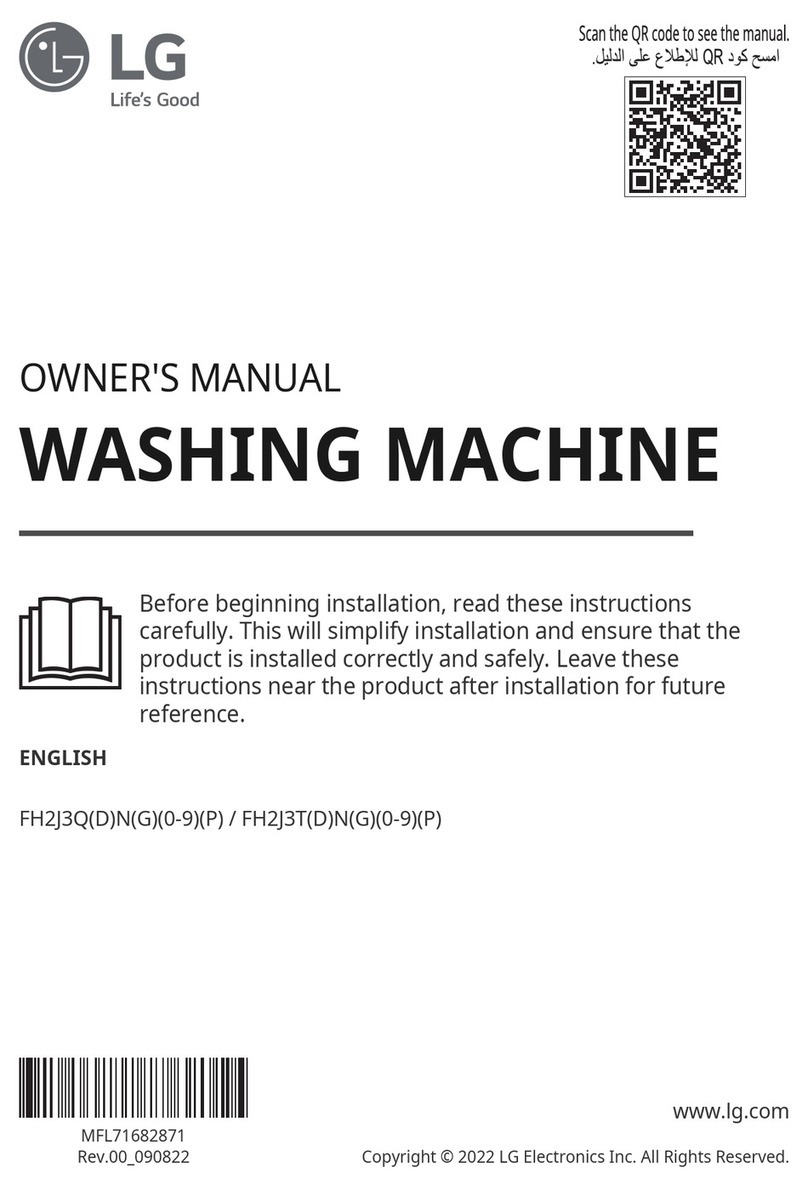
LG
LG FH2J3T Series owner's manual
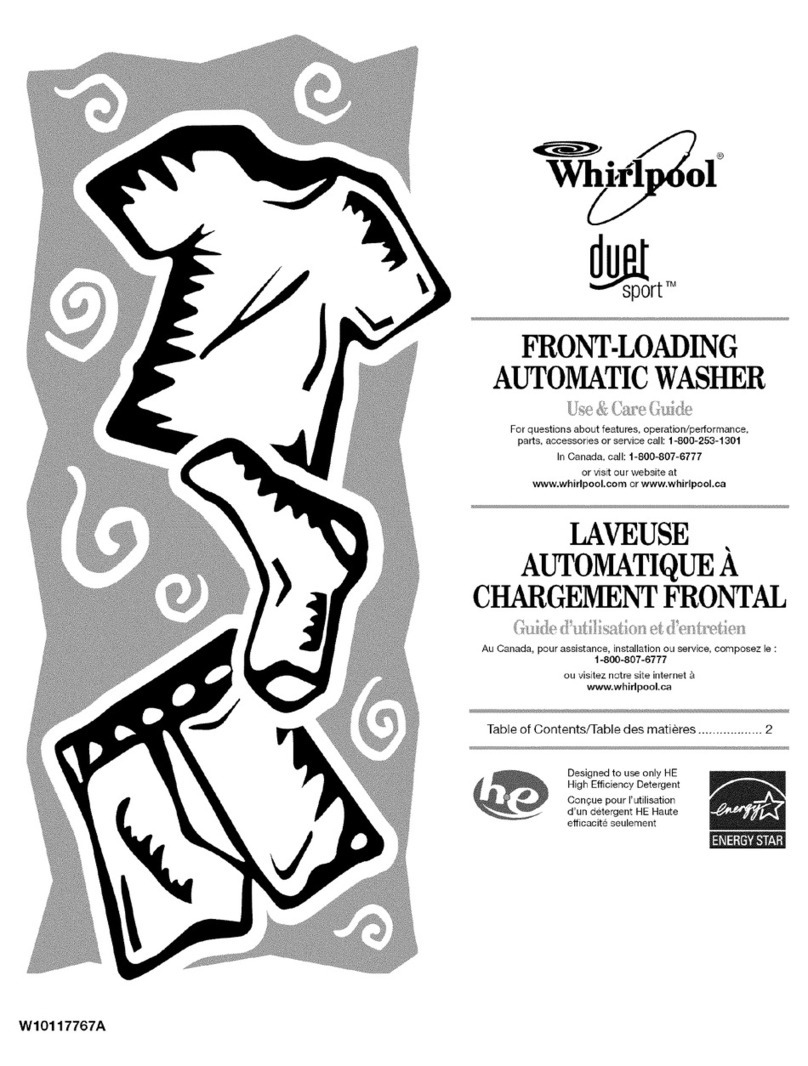
Whirlpool
Whirlpool WFW8300SW02 Use & care guide
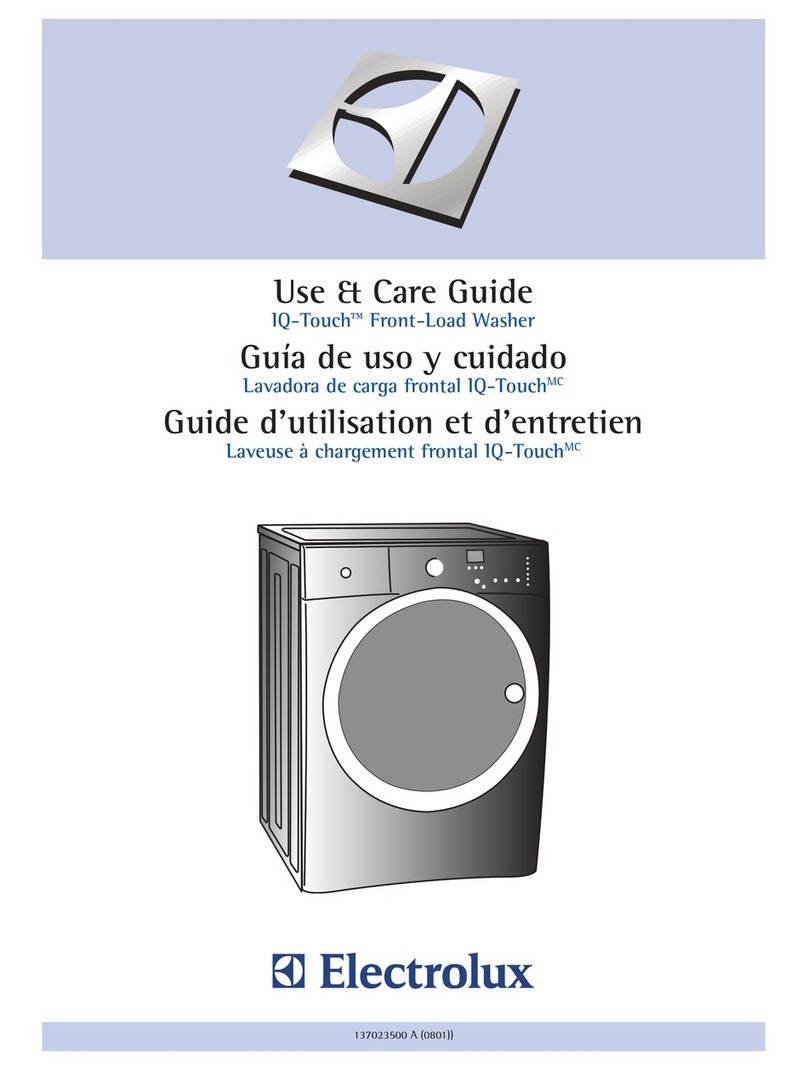
Electrolux
Electrolux EIFLW55HIW - 27" Front-Load Washer Use and care guide

Siemens
Siemens WG54G2APDN User manual and installation instructions
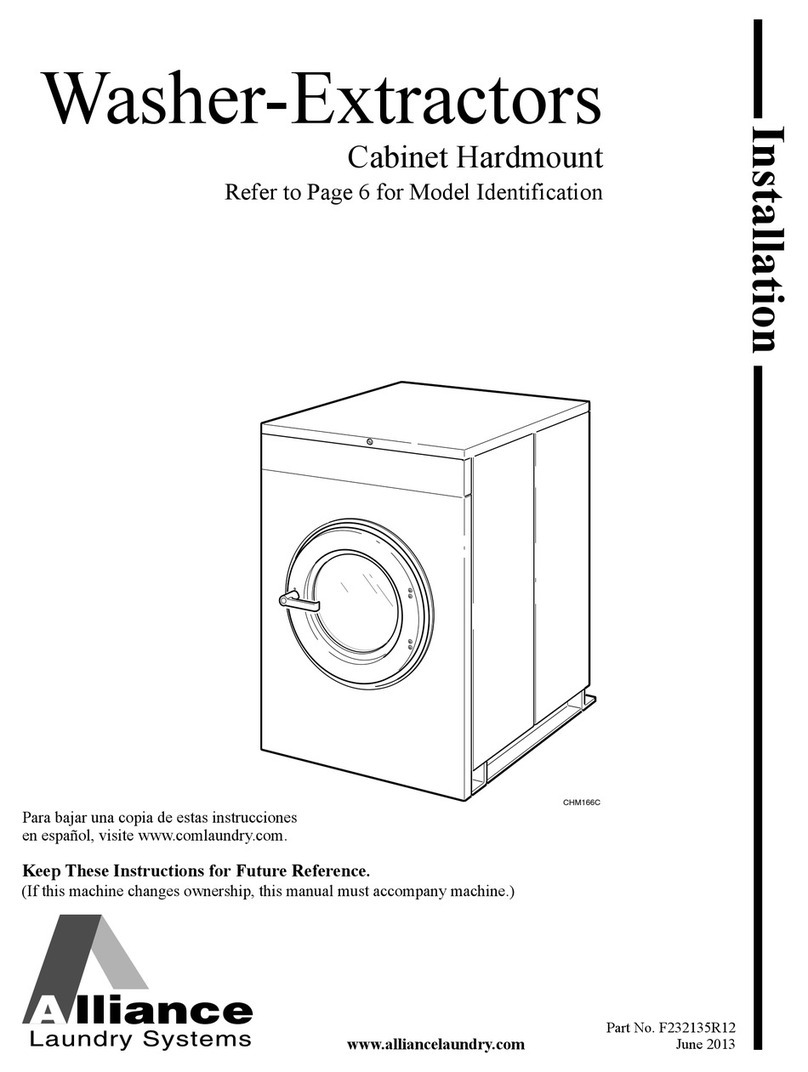
Alliance Laundry Systems
Alliance Laundry Systems F232135R12 Installation
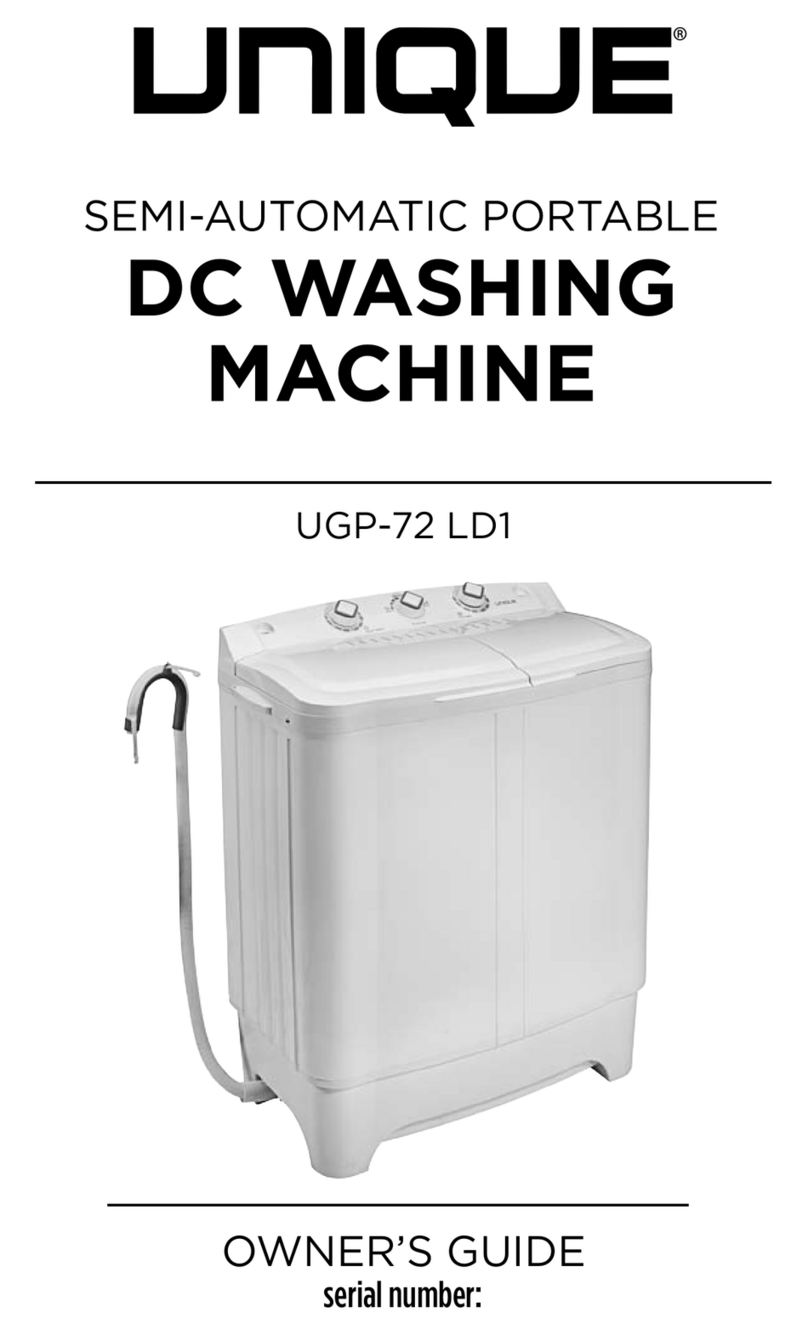
Unique
Unique UGP-72 LD1 owner's guide
